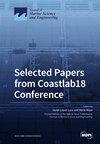Dead on the Beach? Predicting the Drift of Whale Remains Improves Management for Offshore Disposal
IF 2.7
3区 地球科学
Q1 ENGINEERING, MARINE
引用次数: 0
Abstract
Whale mortality and strandings have increased in recent years, with deceased whales often brought to landfill. However, the disposal of whale remains offshore holds significant ecological importance and can be a culturally and ethically sensitive approach. Moreover, offshore disposal mitigates potential risks associated with onshore whale remains disposal, such as the spread of diseases and the logistical challenges of managing large carcasses. A challenge with offshore disposal is defining the best release location to avoid the remains drifting ashore or into shipping channels. Here we compared the drift model outputs using a drift forecast model (SARMAP) for a 14 m whale carcass that was moved offshore in southeast Queensland, Australia, and fitted with a satellite tracker over an observation period of 150 h until positioning signal ceased. The modelling was conducted using different ocean products (BLUElink, HYCOM, and Copernicus), which showed a good agreement with the tracked whale carcass, albeit with changing wind conditions and contrasting currents flowing northward along the coast and, further offshore, flowing south. This case study illustrated that wind was the foremost driver of carcass drift due to the surface area above the water surface. The drift forecast simulations allowed for a reliable prediction of the floating whale drift that can assist authorities with decision making. Offshore disposal of whale carcasses is a sustainable practice but requires good planning and scientific assessment.死在海滩上?预测鲸鱼遗骸的漂移可改善近海处置管理
近年来,鲸鱼死亡和搁浅现象有所增加,死亡的鲸鱼往往被送往垃圾填埋场。然而,在近海处理鲸鱼遗骸具有重要的生态意义,也是一种具有文化和道德敏感性的方法。此外,近海处理还能降低与陆上鲸鱼遗骸处理相关的潜在风险,如疾病传播和管理大型鲸鱼尸体的后勤挑战。近海处理的一个挑战是确定最佳释放地点,以避免遗骸漂流到岸上或进入航道。在此,我们使用漂移预测模型(SARMAP)对漂移模型的输出结果进行了比较,该模型针对的是澳大利亚昆士兰州东南部被移至近海并安装了卫星跟踪器的 14 米鲸鱼尸体,观察期为 150 小时,直至定位信号停止。使用不同的海洋产品(BLUElink、HYCOM 和 Copernicus)进行了建模,结果表明,尽管风力条件不断变化,海流沿海岸线向北流动,而在离岸更远的地方则向南流动,但建模结果与跟踪的鲸鱼尸体十分吻合。这一案例研究表明,由于水面以上的表面积,风是鲸尸漂移的主要驱动力。漂流预测模拟可以对鲸鱼漂浮进行可靠的预测,从而帮助当局做出决策。近海处理鲸鱼尸体是一种可持续的做法,但需要良好的规划和科学的评估。
本文章由计算机程序翻译,如有差异,请以英文原文为准。
求助全文
约1分钟内获得全文
求助全文
来源期刊

Journal of Marine Science and Engineering
Engineering-Ocean Engineering
CiteScore
4.40
自引率
20.70%
发文量
1640
审稿时长
18.09 days
期刊介绍:
Journal of Marine Science and Engineering (JMSE; ISSN 2077-1312) is an international, peer-reviewed open access journal which provides an advanced forum for studies related to marine science and engineering. It publishes reviews, research papers and communications. Our aim is to encourage scientists to publish their experimental and theoretical results in as much detail as possible. There is no restriction on the length of the papers. The full experimental details must be provided so that the results can be reproduced. Electronic files and software regarding the full details of the calculation or experimental procedure, if unable to be published in a normal way, can be deposited as supplementary electronic material.
文献相关原料
| 公司名称 | 产品信息 | 采购帮参考价格 |
|---|
 求助内容:
求助内容: 应助结果提醒方式:
应助结果提醒方式:


